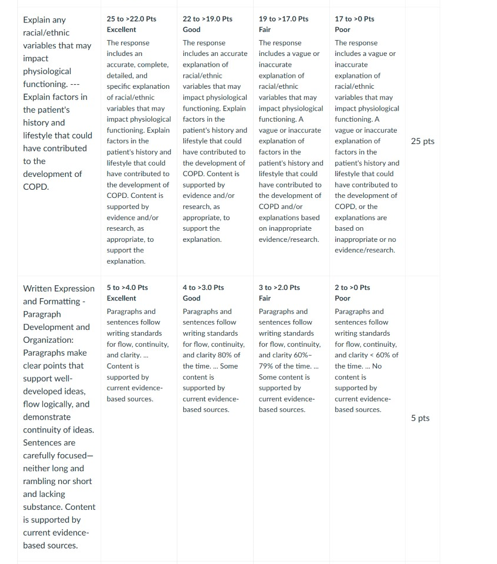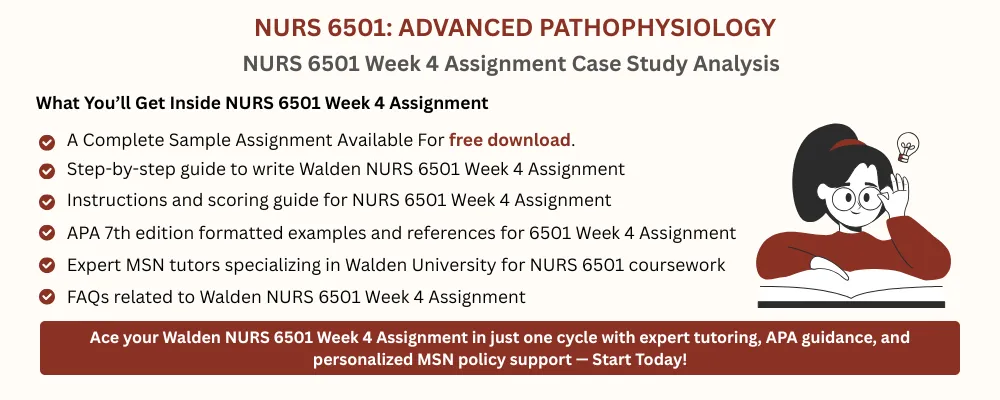NURS 6501 Week 4 Assignment FREE DOWNLOAD
NURS 6501 Week 4 Assignment
Case Study Analysis
Student Name
Walden University
NURS 6501
Professor Name
Date
Case Study Analysis
Factors Contributing to COPD Development
Smoking forty packs of cigarettes over the course of a lifetime is the primary cause of the patient’s COPD. When smoking stimulates immune cells and produces tissue-damaging radicals in the lungs, it damages the alveoli and alters the airways (De Cunto et al., 2020). In addition to smoking, occupational health hazards are a significant contributor to the development of COPD. Even if they do not smoke, mine workers and other workers who regularly come into contact with certain irritants, such silica dust, run the risk of developing chronic airway inflammation and fibrosis (Ike-Samuel et al., 2025). Because these irritants affect cilia function and trigger comparable inflammatory responses in the lungs, exposure to them has the same negative health effects as smoking.
Smoking-Induced Lung Changes
The toxic chemicals in cigarette smoke cause the lung’s neutrophils and macrophages to become activated, producing inflammatory agents and reactive oxygen species. Lung elasticity is decreased as a result of the cells’ digestion of elastin and alveolar walls by proteases such elastase (Heinz, 2020). Because elastic tissue degrades and keeps the lungs too full of air, ineffective breathing results. In order to create a barrel-shaped chest, the diaphragm flattens and the chest wall expands outward. Patients have to rely on more muscles to exhale, which makes breathing more difficult and changes the anatomy of their chest.
Mechanisms of Productive Cough
Patients with COPD who have irritated airways generate excessive mucus that is unable to adequately leave their bodies. Smoking causes the glands beneath the mucosal tissue to enlarge, producing more mucus, and it also causes an excess of goblet cells (Gui et al., 2021). Because the cilia are damaged by the harmful compounds, mucus cannot be removed by the regular cleaning process. The cough reflex is activated to clear blocked airways of mucus. Chronic inflammation’s negative health effects increase nerve sensitivity, which encourages coughing fits. Sputum is produced daily as a result of the ongoing airway alterations that characterize chronic bronchitis.
Alveolar Destruction and Gaseous Exchange
The available gas exchange surface area is decreased when alveoli are destroyed by emphysematous degradation, which leads to hypoxemia (a reduced capacity to diffuse oxygen) and hypercapnia (a reduced capacity to expel carbon dioxide) (Cho & Stout-Delgado, 2020). Hypoxemia impairs the supply of oxygen to muscles, resulting in obvious exhaustion while exerting oneself. Patients can breathe at large lung volumes, which are less effective for the diaphragm, and residual volume rises in hyperinflation. It makes breathing more difficult and develops into dyspnea. Breathlessness causes compensatory tachypnea, which further stresses the respiratory muscles. Chronic hypercapnia maintains anomalies of gas exchange by desensitizing chemoreceptors and decreasing respiratory drive (Palmer & Clegg, 2023).
Susceptibility to Respiratory Infections
Patients with COPD have nearly nonexistent immunological responses (airway defenses), making them vulnerable to a variety of infections. Because of mucus accumulation and ciliary failure, airway pathogens invade the airways. Prolonged inflammation inhibits the removal of pathogens, interferes with the phagocytic activity of alveolar macrophages, and interferes with the generation and recycling of antioxidants (Lugg et al., 2021). Additionally, structural damage like thickening of the bronchial wall prevents the recruitment of immune cells. Recurrent infections in this patient exacerbate the decrease in lung function and raise the likelihood of hospitalization.
Need expert help with your NURS 6501 Week 3 cardiovascular assignment? Get it done with us now!
Instructions To Write NURS 6501 Week 4 Assignment
Need instructions for this assessment? Contact us now and get expert guidance right away!
Instructions File For 6501 Week 4 Assignment
CASE STUDY ANALYSIS
An understanding of the respiratory system is a critically important component of disease diagnosis and treatment. This importance is magnified by the fact that oftentimes, the respiratory system works closely with cardiovascular system. A variety of factors and circumstances that impact the emergence and severity of issues in one system can have a role in the performance of the other.
Effective disease analysis often requires an understanding that goes beyond these systems and their capacity to work together. The impact of patient characteristics, as well as racial and ethnic variables, can also have an important impact.
An understanding of the symptoms of alterations in the respiratory system is a critical step in diagnosis and treatment of many diseases. For APRNs, this understanding can also help educate patients and guide them through their treatment plans.
In this Assignment, you examine a case study and analyze the signs and symptoms presented. You identify the elements that may be factors in the diagnosis, and you explain the implications to patient health.
RESOURCES
Be sure to review the Learning Resources before completing this activity.
Click the weekly resources link to access the resources.
WEEKLY RESOURCES
To prepare:
By Day 1 of this week, you will be assigned to a specific case study scenario for this Case Study Assignment. Please see the “Announcements” section of the classroom for your assignment from your instructor.
The Assignment
In 1-2 pages, you will answer the questions provided following the case scenario. You must use current evidence-based resources to support your answers. Follow APA guidelines. Follow the grading rubric.
BY DAY 7 OF WEEK 4
Submit your Case Study Analysis Assignment by Day 7 of Week 4
Reminder: The College of Nursing requires that all papers submitted include a title page, introduction, summary, and references. The sample paper provided at the Walden Writing Center provides an example of those required elements (available at https://academicguides.waldenu.edu/writingcenter/templates). All papers submitted must use this formatting.
SUBMISSION INFORMATION
Before submitting your final assignment, you can check your draft for authenticity. To check your draft, access the Turnitin Drafts from the Start Here area.
To submit your completed assignment, save your Assignment as WK4Assgn2_LastName_Firstinitial
Then, click on Start Assignment near the top of the page.
Next, click on Upload File and select Submit Assignment for review.
NURS 6501 Week 4 Assignment Rubrics



References For NURS 6501 Week 4 Assignment
Cho, S. J., & Stout-Delgado, H. W. (2020). Aging and lung disease. Annual Review of Physiology, 82(1), 433–459. https://doi.org/10.1146/annurev-physiol-021119-034610
De Cunto, G., Cavarra, E., Bartalesi, B., Lucattelli, M., & Lungarella, G. (2020). Innate immunity and cell surface receptors in the pathogenesis of COPD: Insights from mouse smoking models. International Journal of Chronic Obstructive Pulmonary Disease, Volume 15, 1143–1154. https://doi.org/10.2147/copd.s246219
Gui, X., Yang, Z., & Li, M. D. (2021). Effect of cigarette smoke on gut microbiota: State of knowledge. Frontiers in Physiology, 12, 673341. https://doi.org/10.3389/fphys.2021.673341
Heinz, A. (2020). Elastases and elastokines: elastin degradation and its significance in health and disease. Critical Reviews in Biochemistry and Molecular Biology, 55(3), 252–273. https://doi.org/10.1080/10409238.2020.1768208
Ike-Samuel, N. S., Ekwueme, O. C., & Udeh, S. C. (2025). Prevalence and determinants of restrictive lung disorder among quarry workers at the Umuoghara quarry site, Ebonyi State, Nigeria: a cross-sectional study. BMC Pulmonary Medicine, 25(1). https://doi.org/10.1186/s12890-025-03497-0
Lugg, S. T., Scott, A., Parekh, D., Naidu, B., & Thickett, D. R. (2021). Cigarette smoke exposure and alveolar macrophages: mechanisms for lung disease. Thorax, 77(1). https://doi.org/10.1136/thoraxjnl-2020-216296
Palmer, B. F., & Clegg, D. J. (2023). Respiratory acidosis and respiratory alkalosis: Core curriculum 2023. American Journal of Kidney Diseases, 82(3), 347–359. https://doi.org/10.1053/j.ajkd.2023.02.004
Best Professors To Choose From For NURS 6501 Class
- Dr. Mary Smith
- Dr. Tara Harris
- Dr. Mahaman Moussa
- Dr. Annaliza (Anna Liza) Villena
- Dr. Morgan Skinner
(FAQs) related to NURS 6501 Week 4 Assignment
Question 1: Where can I download a free sample for NURS 6501 Week 4 Assignment?
Answer 1: Download a free sample from Tutors Academy.
Question 2: Where can I find the rubrics and instruction file for NURS 6501 Week 4 Assignment?
Answer 2: Get the rubric and instruction file from the Tutors Academy website.
Do you need a tutor to help with this paper for you with in 24 hours.
- 0% Plagiarised
- 0% AI
- Distinguish grades guarantee
- 24 hour delivery

